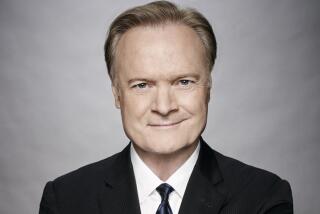Peacock Clinches Top Spot
- Share via
The just-ended television season has seen the NBC peacock continue to strut ahead of the flock, while the major networks as a group keep getting feathers plucked by a host of viewing options.
NBC finished first in the 1997-98 television campaign that began in September and concluded Wednesday--closing its third straight year as reigning prime-time champ with a commanding victory during the May rating sweeps, which local TV stations use to negotiate prices when they sell advertising.
The major networks in general, however, face a disheartening reality, preparing for the traditional summer lull knowing that gradual erosion of their audience continues unabated, with no apparent end in sight.
In that respect, the latest TV season may prove a watershed year, given that the WB network (with the teen soap “Dawson’s Creek”) as well as cable channels such as Comedy Central (offering the animated “South Park”) and USA network (with “Moby Dick”) have demonstrated that they too can achieve breakthrough ratings, albeit by their lesser standards.
By contrast, the major networks struggled, often watching the bottom drop out on ratings when they made scheduling changes. Even NBC trailed the WB and UPN with one short-lived show, “Built to Last,” underscoring the freedom viewers now have to choose from a growing menu of channels at a moment’s notice.
Buffeted by that competition, the four major networks saw their combined audience diminish by 2.3 million viewers during an average hour of prime time--a 4% decrease that mirrors the percentage of viewers who turned elsewhere last season, despite the infusion CBS received from the Winter Olympics.
Nothing demonstrates how quickly disaster can strike better than ABC, which in two years has suffered a ratings decline of more than 20%, leaving a network that ranked No. 1 just three years ago third in both total viewing and the key demographics that most directly translate into advertising dollars.
The failure rate on new programs remained staggeringly high. ABC and NBC each renewed just two out of eight and 11 series they introduced last fall, respectively, while CBS won’t bring back any of its seven newcomers.
The season did possess its share of individual ratings highlights, including “Seinfeld’s” finale (the sixth most-watched entertainment event ever), Denver’s nail-biting Super Bowl win, the recent NBC miniseries “Merlin,” ABC’s musical remake “Cinderella” and the 38 million people who tuned in to see Tara Lipinski win the Olympic gold medal in ice skating.
Even so, the overall picture appeared bleak. Of the four major networks, only CBS avoided losing viewers this season, due almost entirely to the Olympics. Though ratings fell short of expectations, the Winter Games helped CBS attract people who aren’t normally watching network television, only to see them flee just as quickly.
NBC topped all comers by averaging 14.9 million viewers in prime time--a 2% audience dip compared to last year, despite televising the Super Bowl, World Series and “Seinfeld.” (Those two sports events previously aired on Fox, which inflated its year-ago results.)
CBS averaged 14.1 million viewers, a modest 2% gain. ABC slipped to an average audience of 12.2 million, and Fox delivered 10.6 million viewers.
Fox still comes out of the season with much to crow about, including a clear rookie of the year in “Ally McBeal” and another competitive milestone, as the 11-year-old network beat both ABC and CBS among adults 18 to 49, the age group most coveted by advertisers.
It was a breakthrough year for the WB network as well. Fueled by the teen dramas “Dawson’s Creek,” “7th Heaven” and “Buffy the Vampire Slayer,” the WB’s audience jumped 25%, to about 4.5 million people during the hours it programs.
In so doing, WB passed archrival UPN, which sought to alter its programming philosophy and fell off 10%, to 4 million viewers. While handicapped nationally by airing on weak stations in smaller markets, WB’s impact is more significant in big cities such as New York and Los Angeles.
Quickly becoming the most popular choice among teenagers, the WB demonstrated how niche-oriented channels are whittling away at the networks. In similar fashion, cable’s Nickelodeon out-rates the major networks among children at 8 p.m., despite its availability in less than three-quarters of all homes.
While the four major networks accounted for a record low 58% of prime-time viewing, cable continued its steady ascent, with aggregate viewing of basic cable channels up more than 10% for the season.
Cable also weathered the barrage of big network movies, miniseries and specials during the May sweeps, as both basic and pay channels averaged a 9% increase over last year.
Broadcasters have reacted to press reports about their decline and cable’s growth by more aggressively touting their merits. NBC, for example, points out that the actual number of people watching the major networks today is higher than 30 years ago, with the rise in population offsetting a declining share of audience.
Network television also remains the only medium capable of reaching the kind of national audience “Seinfeld” or the Super Bowl reels in. So far, that dynamic has helped keep advertising rates high even as the networks’ percentage of viewing diminishes.
The number of regularly scheduled programs possessing broad appeal, however, continues to drop rapidly. This season, six prime-time series averaged more than 20 million viewers per week, and only two of those--”Monday Night Football” and “Touched by an Angel”--didn’t air Thursdays on NBC. Three years ago, 19 programs finished the season above that level.
As a result, programming executives have good reason to face the future with trepidation, especially since the TV landscape will experience further crowding in September, when both WB and UPN will expand to five nights of programming.
Even NBC’s “Must-See TV” Thursday lineup will be tested minus “Seinfeld,” whose farewell audience helped boost the network’s May sweeps results.
Between “Seinfeld” and “Merlin,” NBC put a hex on the competition, winning the May survey by a vast margin over second-place CBS. Only NBC and the WB posted audience gains versus last year, while Fox ran fourth in overall viewing but easily bested both ABC and CBS from a demographic standpoint.
“Seinfeld,” meanwhile, exits the stage as TV’s top-rated program, as the final episode helped provide a comfortable advantage over “ER,” which ranked No. 1 last season.
ABC’s woes were reflected in a 15% audience loss for its most-watched entertainment show, “Home Improvement,” as the network’s once-dominant Tuesday lineup tumbled.
* L.A. WINNERS & LOSERS: KNBC-TV had the top-rated newscasts, but the news for local news is far from rosy. F31
* THE TOP 20: NBC had nine of the season’s highest-rated series. F31
Top 20 Series of ‘97-98 Season
*--*
Average Show Network Viewers (in millions) 1. “Seinfeld” NBC 34.1 2. “ER” NBC 30.2 3. “Veronica’s Closet” NBC 24.4 4. “Friends” NBC 24.0 5. “Touched by an Angel” CBS 21.8 6. “Monday Night Football” ABC 21.0 7. “Union Square” NBC 19.9 8. “60 Minutes” CBS 19.8 9. “CBS Sunday Night Movie” CBS 19.4 10. “Home Improvement” ABC 18.4 11. “The X-Files” Fox 17.1 12. “Just Shoot Me” NBC 17.0 13. “Frasier” NBC 16.8 14. “The Drew Carey Show” ABC 16.6 15. “King of the Hill” Fox 16.3 16. “Dateline” (Tuesday) NBC 15.4 17. “Dateline” (Monday) NBC 15.33 18. “The Simpsons” Fox 15.31 19. “20/20” ABC 15.01 20. “NYPD Blue” ABC 15.00
*--*
SOURCE: Nielsen Media Research
More to Read
The biggest entertainment stories
Get our big stories about Hollywood, film, television, music, arts, culture and more right in your inbox as soon as they publish.
You may occasionally receive promotional content from the Los Angeles Times.










